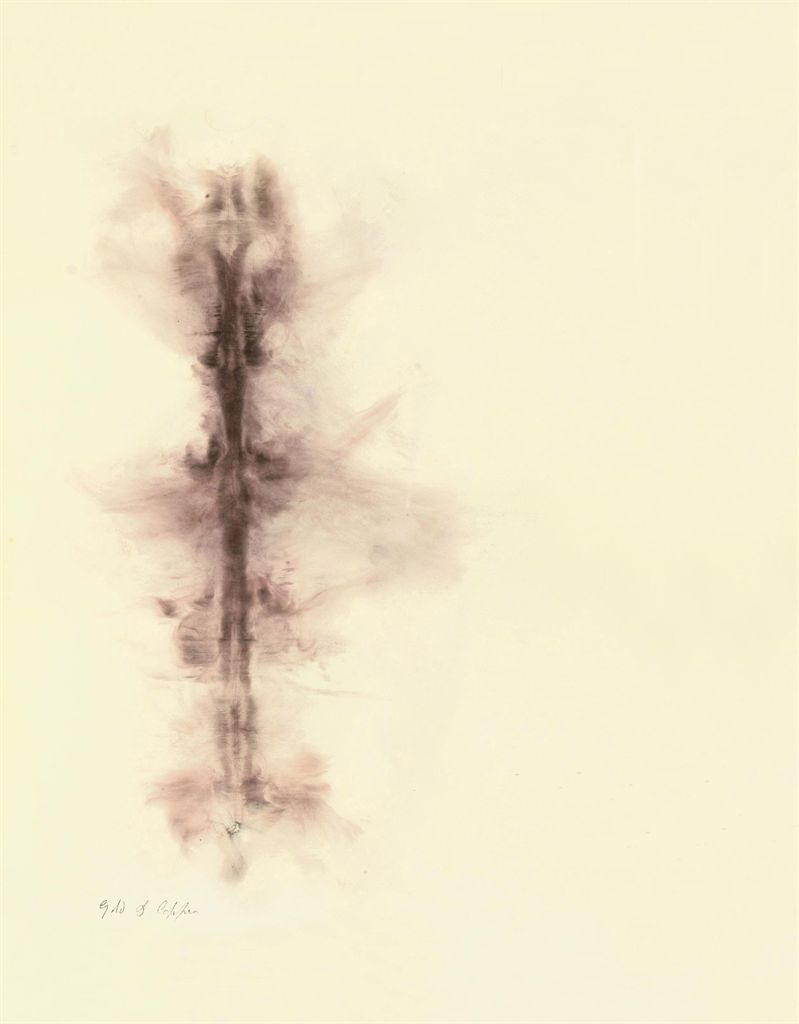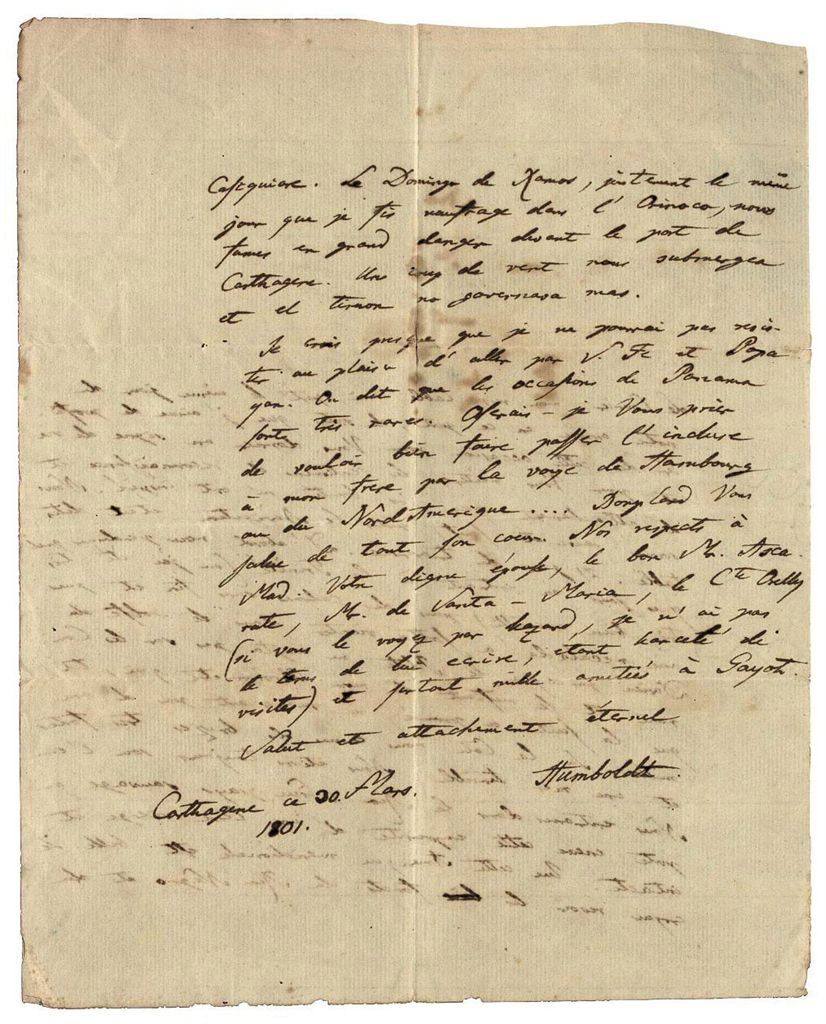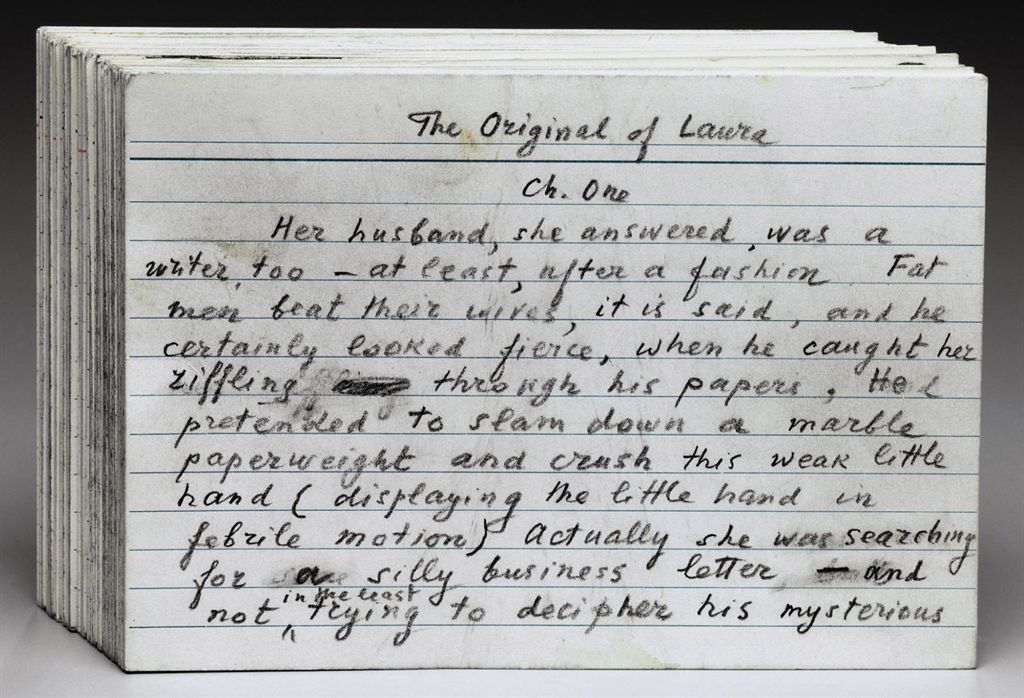FARADAY, Michael (1791-1867). 'Deflagrations of Gold, and other metals, on vellum' (title in secretarial hand on verso of front free end paper), 35 deflagrations, on the pages of an album of 'prepared vellum' by Charles Terry (blind stamp), 31 labelled in autograph by Faraday ('Silver leaf' (3), 'Silver' (2), 'Gold', 'Copper Silver' (5), 'Iron' (2), 'Zinc' (3), 'Gold & Silver', 'Gold & Copper', 'Lead' (2), 'Gold leaf', 'Ant[imon]y', 'Bismuth', 'Silver gilt', 'Gold .1/800', 'Gold', 'Silver .1/350', 'Tin' (2), 'Copper .1/350' and 'Platinum'), the copper silver wire used for the deflagration on f.5 surviving in the gutter, 14 blanks, original purple morocco, tooled in blind and gilt (worn and rubbed at spine and extremities). Provenance : presented to Faraday's friend and fellow electrical experimenter J[ohn] P[eter] Gassiot (1797-1877) by S[arah] F[araday] 'as a remembrance' (presumably after Faraday's death in 1867); given by Miss H. Gassiot to Robert H. Scott (presumably a relative of Gassiot's wife, Elizabeth née Scott), 1877; and by Scott to Prof E[leuthère] Mascart (French physicist, installed the weather station at the top of the Eiffel Tower, 1837-1908) in 1894 (inscriptions to Michael Faraday's visiting card, pasted inside upper cover). Faraday discusses the process of deflagration in his 1857 paper 'Deflagrations of Gold (and other metals) -- heat -- pressure, &c': the process seems to have consisted in exploding wires of various different metals and compounds by means of a battery, sometimes using atmospheres of oxygen and hydrogen, on glass plates and other media. Gassiot, who had corresponded with Faraday as early as 1839 on electrical experimental subjects, was at this time vice-president of the Royal Society, and collaborated closely with Faraday in experiments on electrical discharges in evacuated tubes in early 1858: a memento of this period of Faraday's life was therefore a particularly appropriate gift. The Royal Institution holds a series of microscope slides of deflagrations, chiefly of gold.
FARADAY, Michael (1791-1867). 'Deflagrations of Gold, and other metals, on vellum' (title in secretarial hand on verso of front free end paper), 35 deflagrations, on the pages of an album of 'prepared vellum' by Charles Terry (blind stamp), 31 labelled in autograph by Faraday ('Silver leaf' (3), 'Silver' (2), 'Gold', 'Copper Silver' (5), 'Iron' (2), 'Zinc' (3), 'Gold & Silver', 'Gold & Copper', 'Lead' (2), 'Gold leaf', 'Ant[imon]y', 'Bismuth', 'Silver gilt', 'Gold .1/800', 'Gold', 'Silver .1/350', 'Tin' (2), 'Copper .1/350' and 'Platinum'), the copper silver wire used for the deflagration on f.5 surviving in the gutter, 14 blanks, original purple morocco, tooled in blind and gilt (worn and rubbed at spine and extremities). Provenance : presented to Faraday's friend and fellow electrical experimenter J[ohn] P[eter] Gassiot (1797-1877) by S[arah] F[araday] 'as a remembrance' (presumably after Faraday's death in 1867); given by Miss H. Gassiot to Robert H. Scott (presumably a relative of Gassiot's wife, Elizabeth née Scott), 1877; and by Scott to Prof E[leuthère] Mascart (French physicist, installed the weather station at the top of the Eiffel Tower, 1837-1908) in 1894 (inscriptions to Michael Faraday's visiting card, pasted inside upper cover). Faraday discusses the process of deflagration in his 1857 paper 'Deflagrations of Gold (and other metals) -- heat -- pressure, &c': the process seems to have consisted in exploding wires of various different metals and compounds by means of a battery, sometimes using atmospheres of oxygen and hydrogen, on glass plates and other media. Gassiot, who had corresponded with Faraday as early as 1839 on electrical experimental subjects, was at this time vice-president of the Royal Society, and collaborated closely with Faraday in experiments on electrical discharges in evacuated tubes in early 1858: a memento of this period of Faraday's life was therefore a particularly appropriate gift. The Royal Institution holds a series of microscope slides of deflagrations, chiefly of gold.
FARADAY, Michael (1791-1867). 'Deflagrations of Gold, and other metals, on vellum' (title in secretarial hand on verso of front free end paper), 35 deflagrations, on the pages of an album of 'prepared vellum' by Charles Terry (blind stamp), 31 labelled in autograph by Faraday ('Silver leaf' (3), 'Silver' (2), 'Gold', 'Copper Silver' (5), 'Iron' (2), 'Zinc' (3), 'Gold & Silver', 'Gold & Copper', 'Lead' (2), 'Gold leaf', 'Ant[imon]y', 'Bismuth', 'Silver gilt', 'Gold .1/800', 'Gold', 'Silver .1/350', 'Tin' (2), 'Copper .1/350' and 'Platinum'), the copper silver wire used for the deflagration on f.5 surviving in the gutter, 14 blanks, original purple morocco, tooled in blind and gilt (worn and rubbed at spine and extremities). Provenance : presented to Faraday's friend and fellow electrical experimenter J[ohn] P[eter] Gassiot (1797-1877) by S[arah] F[araday] 'as a remembrance' (presumably after Faraday's death in 1867); given by Miss H. Gassiot to Robert H. Scott (presumably a relative of Gassiot's wife, Elizabeth née Scott), 1877; and by Scott to Prof E[leuthère] Mascart (French physicist, installed the weather station at the top of the Eiffel Tower, 1837-1908) in 1894 (inscriptions to Michael Faraday's visiting card, pasted inside upper cover). Faraday discusses the process of deflagration in his 1857 paper 'Deflagrations of Gold (and other metals) -- heat -- pressure, &c': the process seems to have consisted in exploding wires of various different metals and compounds by means of a battery, sometimes using atmospheres of oxygen and hydrogen, on glass plates and other media. Gassiot, who had corresponded with Faraday as early as 1839 on electrical experimental subjects, was at this time vice-president of the Royal Society, and collaborated closely with Faraday in experiments on electrical discharges in evacuated tubes in early 1858: a memento of this period of Faraday's life was therefore a particularly appropriate gift. The Royal Institution holds a series of microscope slides of deflagrations, chiefly of gold.
FARADAY, Michael (1791-1867). 'Deflagrations of Gold, and other metals, on vellum' (title in secretarial hand on verso of front free end paper), 35 deflagrations, on the pages of an album of 'prepared vellum' by Charles Terry (blind stamp), 31 labelled in autograph by Faraday ('Silver leaf' (3), 'Silver' (2), 'Gold', 'Copper Silver' (5), 'Iron' (2), 'Zinc' (3), 'Gold & Silver', 'Gold & Copper', 'Lead' (2), 'Gold leaf', 'Ant[imon]y', 'Bismuth', 'Silver gilt', 'Gold .1/800', 'Gold', 'Silver .1/350', 'Tin' (2), 'Copper .1/350' and 'Platinum'), the copper silver wire used for the deflagration on f.5 surviving in the gutter, 14 blanks, original purple morocco, tooled in blind and gilt (worn and rubbed at spine and extremities). Provenance : presented to Faraday's friend and fellow electrical experimenter J[ohn] P[eter] Gassiot (1797-1877) by S[arah] F[araday] 'as a remembrance' (presumably after Faraday's death in 1867); given by Miss H. Gassiot to Robert H. Scott (presumably a relative of Gassiot's wife, Elizabeth née Scott), 1877; and by Scott to Prof E[leuthère] Mascart (French physicist, installed the weather station at the top of the Eiffel Tower, 1837-1908) in 1894 (inscriptions to Michael Faraday's visiting card, pasted inside upper cover). Faraday discusses the process of deflagration in his 1857 paper 'Deflagrations of Gold (and other metals) -- heat -- pressure, &c': the process seems to have consisted in exploding wires of various different metals and compounds by means of a battery, sometimes using atmospheres of oxygen and hydrogen, on glass plates and other media. Gassiot, who had corresponded with Faraday as early as 1839 on electrical experimental subjects, was at this time vice-president of the Royal Society, and collaborated closely with Faraday in experiments on electrical discharges in evacuated tubes in early 1858: a memento of this period of Faraday's life was therefore a particularly appropriate gift. The Royal Institution holds a series of microscope slides of deflagrations, chiefly of gold.















Testen Sie LotSearch und seine Premium-Features 7 Tage - ohne Kosten!
Lassen Sie sich automatisch über neue Objekte in kommenden Auktionen benachrichtigen.
Suchauftrag anlegen